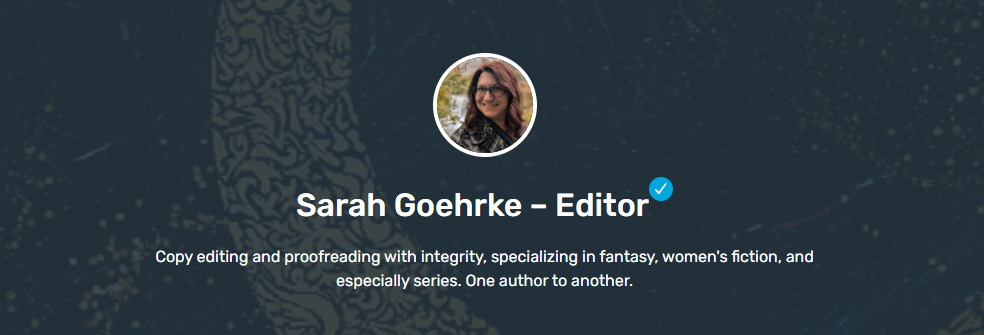
Sarah the Editor
Copy editing and proofreading services available!
Keep scrolling for more information about what these services include!
AI Note:
I have not ever, nor will I ever, use generative AI in any editing, writing, or other professional services. Everything you see or commission from me will be 100% human-created—and I expect the same from everyone I work with.
Editing by humans, for humans. With integrity.
Let’s work together
Interested in learning more about my editing processes and whether we may be a good working fit? Reach out today!
Direct contact through this form, or check out my profile on Reedsy!
Scroll down for descriptions, timing, and pricing for copy editing and proofreading—I’m ready to work with you, meet you where you are, and always open to discussions.
Copy editing
When I copy edit your work, I am looking at the entire story and how you tell it. You’ve already done a developmental edit at this point—with another editor, or with beta readers, or with your wall—and you’re ready to finesse your work.
What I provide:
In-line comments throughout your manuscript
Track changes on for any grammar/spelling updates, and comments flagging any questions
A style sheet that includes every character in your work with brief physical and personality/plot descriptions to ensure worldbuilding and characters are consistent
Three-week turnaround
Grammarly has a great breakdown on what different types of editing entail:
What is copy editing?
Copy editing takes place after a substantive edit but before proofreading. The objective of copy editing is to polish the copy so that it’s clear while retaining the author’s voice and meaning. Copy is defined as “matter to be printed,” and a copy editor is responsible for this polishing step. They comb through a written work to identify and correct:
Grammar
Spelling
Tone and style deviations
Wordiness
Clunky transitions
Confusing syntax
Problematic or misused words
Uneven flow
After a copy edit, the copy should be a cohesive, readable piece that adheres to the publication’s tone and style guidelines.
Timing/Deliverables/Pricing
TIMING:
Guaranteed return on copy edits in three weeks, often less!
DELIVERABLES:
In-line: in-document, Track Changes-enabled comments, corrections, and suggestions
Style sheet: a new document provided to you for your work’s style guide, to establish and adhere to consistency within the work—great for series to ensure everything created in Book One carries through the same to Book Three! In-world styling, where italics are used, character descriptions, and more.
PRICING
I typically work by the Editorial Freelancers Association's rates, which sets us at $0.025/word for a copy edit.
Payments will be invoiced at 50% upfront and 50% upon completion; final edit to be sent upon receipt of payment in full.
Proofreading
When I proofread your work, I’m your final line of defense before sending it into the world. You’ve already done your plot, worldbuilding, and character edits; you’ve already checked your overall flow; you’re ready for those last looks so the story reads like the dazzling final product it’s ready to be.
What I provide:
Track changes in your document for any spelling/formatting errors I fix
In-line comments as needed to flag questions or concerns (or especially great lines!)
Two-week turnaround
Grammarly has a great breakdown on what different types of editing entail:
What is proofreading?
Proofreading takes place after the copy editor has completed their work and before the work is published. This step gets its name from the traditional typesetting process. Before multiple book copies were printed, a test version of a manuscript or book, called a “galley proof,” would be created. Proofreaders would read through these proofs to spot and fix mistakes before moving them forward to printing.
A proofreader is a specialized editor who’s tasked with reviewing the mechanical elements of the copy. They are the final set of eyes to address issues involving:
Grammar
Spelling
Punctuation
Capitalization
Formatting
On-page layout
In addition to correcting mechanical, fine line oversights that might have slipped through the editing process, proofreaders are responsible for fixing on-page elements. These might include inconsistent headers and subheads, page numbers and breaks, placement of visual assets like a table or chart, and other formatting issues.
Timing/Deliverables/Pricing
TIMING:
Guaranteed return on proofreads in two weeks, often less!
DELIVERABLES:
You get your preference of returned comments:
In-line: in-document, Track Changes-enabled, grammar/spelling/formatting adjustments. All you do is accept (or deny!) and it’s ready to go!
In-line recommended for those not yet in final-formatting phases, still working in Word, and wanting that additional set of professional eyes on everything.
Separate: a separate document with two lines per noted error—line one (Error), line two (Correction), where each will be the same line of text with the error and proposed amendment highlighted, easily findable in your manuscript.
Separate document recommended for those who need a very final proofread, don’t want to tempt fate with anyone else in a formatted document, and/or for reformatted works needing a new proof to ensure everything is at its best!
PRICING
I typically work by the Editorial Freelancers Association's rates, which sets us at $0.017/word for a proofread.
Payments will be invoiced at 50% upfront and 50% upon completion; final edit to be sent upon receipt of payment in full.






